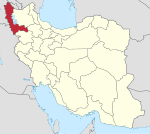Mahabad
You can help expand this article with text translated from the corresponding article in Persian. (May 2015) Click [show] for important translation instructions.
|
Mahabad
مهاباد | |
|---|---|
City | |
| Coordinates: 36°45′47″N 45°43′20″E / 36.76306°N 45.72222°E | |
| Country | |
| Province | West Azerbaijan |
| County | Mahabad |
| Bakhsh | Central |
| Population (2016 Census) | |
| • Urban | 168,393 |
| Time zone | UTC+3:30 (IRST) |
| • Summer (DST) | UTC+4:30 (IRDT) |
| Area code | 044 |
| Website | www.mohabad-ag.ir |
| [1] | |
Mahabad (Template:Lang-fa, Template:Lang-ku), also Romanized as Mihābād and Muhābād,[2] is a city and capital of Mahabad County, West Azerbaijan Province, Iran. At the 2006 census, its population was 168,000 in 31,000 families.[3]
The city lies south of Lake Urmia in a narrow valley 1,300 metres above sea level.[4][5]
Name
Mahabad first became the name of the city after World War I, during the reign of the Pahlavi shah (king) Reza Shah (r. 1925–1941). Before that, it was known as Savojbolagh, a Persian corruption of the Turkic word soghuk bulak (meaning "cold spring"). The Kurdish version was Sablagh.[6][7]
History

Savojbolagh is first attested in the 16th century, during the Safavid era.[6] Mukri Kurds participated in several wars between Safavid dynasty and Ottoman Empire, and gained more predominance. In 17th century AD, Savojbolagh became the seat of Mukri principality (known as Mukriyān in Sorani Kurdish and Mokriyān in Persian). Many believe Budaq Sultan Mukri, who built Savojbolagh's Jameh Mosque is the founder of the current town.
Republic of Mahabad
Mahabad was the capital of the short-lived Republic of Mahabad, which was declared independent on January 1, 1946 under the leadership of Kurdish nationalist Qazi Muhammad.
The republic received strong support from the Soviet Union, which occupied Iran during the same era. It included the majority Kurdish-speaking towns of Bukan, Piranshahr, Sardasht and Oshnavieh.[8]
After an agreement brokered by the United States, the Soviets agreed to leave Iran, and sovereignty was restored to the Shah in 1947. The Shah ordered an invasion of the Republic of Mahabad shortly afterwards, the leaders of the republic including Qazi Muhammad were arrested and executed.[9][10][11] Qazi Muhammad was hanged on 31 March 1947. At the behest of Archibald Roosevelt Jr., who argued that Qazi had been forced to work with the Soviets out of expediency, U.S. ambassador to Iran George V. Allen urged the Shah not to execute Qazi or his brother, only to be reassured: "Are you afraid I'm going to have them shot? If so, you can rest your mind. I am not." Roosevelt later recounted that the order to have the Qazis killed was likely issued "as soon as our ambassador had closed the door behind him," adding with regard to the Shah: "I never was one of his admirers."[12]
Islamic Republic of Iran
On 7 May 2015, the people of the city rioted following the unexplained death on 4 May 2015 of Farinaz Khosravani, a hotel chambermaid. Khosravani fell to her death from a fourth-floor window of the Tara hotel, the hotel where she worked. Anger mounted following reports that Khosravani died attempting to escape an official who was threatening to rape her. The rioters reportedly set fire to the hotel where Khosravani worked.[13]
Language and religion
Most of Mahabad is populated by Kurds who follow the Sunni branch of Islam. Besides Kurdish, many speak Persian and Azeri Turkic as well.[14] Neo-Aramaic-speaking Jews originally used to inhabit the city as well.[6]
References
- ^ Statistical. "Center of Iran > Home". www.amar.org.ir. Archived from the original on 2018-12-02. Retrieved 2018-08-21.
- ^ Mahabad can be found at GEOnet Names Server, at this link, by opening the Advanced Search box, entering "-3073397" in the "Unique Feature Id" form, and clicking on "Search Database".
- ^ "Census of the Islamic Republic of Iran, 1385 (2006)" (Excel). Statistical Center of Iran. Archived from the original on 2011-09-20.
- ^ S. J. Laizer, Martyrs, Traitors, and Patriots: Kurdistan after the Gulf War, Zed Books, 1996, ISBN 978-1-85649-396-3, p. 56.
- ^ Marion Farouk-Sluglett, Peter Sluglett, Iraq Since 1958: From Revolution to Dictatorship, .B.Tauris, 2001, ISBN 978-1-86064-622-5, p. 28.
- ^ a b c Minorsky & Bosworth 1997, p. 92.
- ^ Hassanpour 1989, p. 511.
- ^ McDowall, David (2004). A modern history of the Kurds. I.B. Tauris. pp. 244–245. ISBN 1-85043-416-6. Retrieved 2012-11-18.
- ^ McDowall, David, A Modern History of the Kurds, I. B. Tauris, 1996 (Current revision at May 14, 2004). ISBN 1-86064-185-7.
- ^ [1] Archived September 7, 2005, at the Wayback Machine
- ^ [2] Archived April 25, 2006, at the Wayback Machine
- ^ Wilford, Hugh (2013). America's Great Game: The CIA's Secret Arabists and the Making of the Modern Middle East. Basic Books. p. 53. ISBN 978-0-465-01965-6.
- ^ "Riot Erupts in Iran's Kurdish Capital Over Woman's Death". The New York Times. 7 May 2015.
- ^ Eagleton & Neumann 1986, p. 213.
Sources
- Eagleton, W. & Neumann, R. (1986). "Mahābād". In Bosworth, C. E.; van Donzel, E.; Lewis, B. & Pellat, Ch. (eds.). The Encyclopaedia of Islam, Second Edition. Volume V: Khe–Mahi. Leiden: E. J. Brill. pp. 213–214. ISBN 978-90-04-07819-2.
- Hassanpour, Amir (1989). "Būkān". In Yarshater, Ehsan (ed.). Encyclopædia Iranica, Volume IV/5: Brick–Burial II. London and New York: Routledge & Kegan Paul. p. 511. ISBN 978-0-71009-128-4.
- Minorsky, Vladmir & Bosworth, C.E. (1997). "Sāwd̲j̲-Bulāḳ". In Bosworth, C. E.; van Donzel, E.; Heinrichs, W. P. & Lecomte, G. (eds.). The Encyclopaedia of Islam, Second Edition. Volume IX: San–Sze. Leiden: E. J. Brill. p. 92. ISBN 978-90-04-10422-8.


